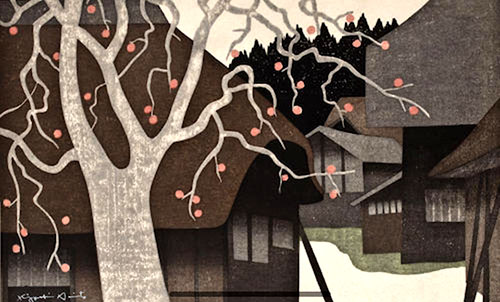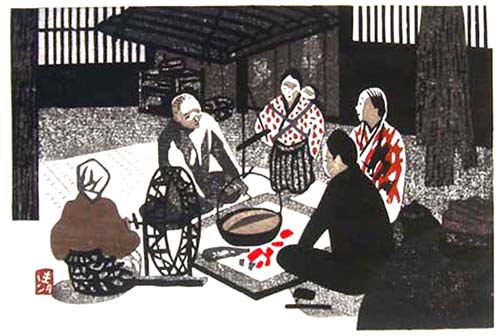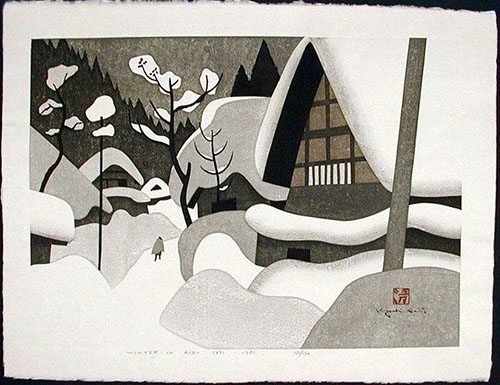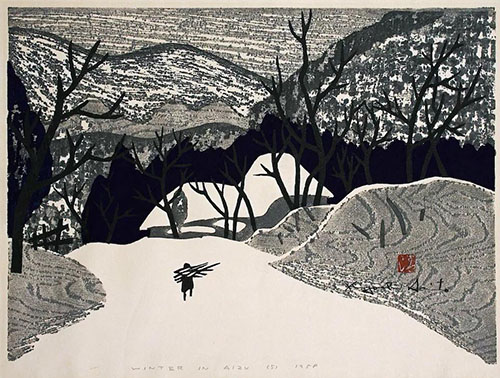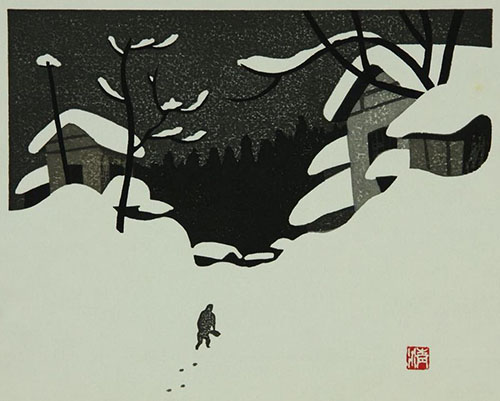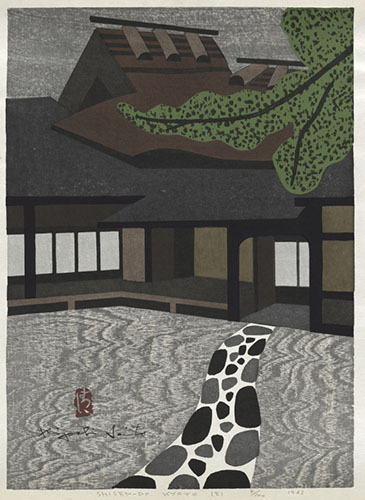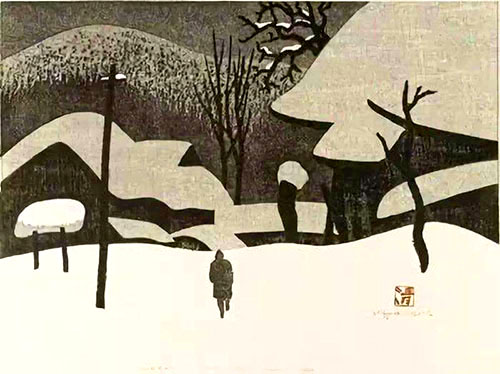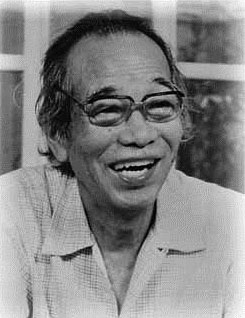
У Сайто Киёси (斎藤清) (1907-1997) свой собственный стиль. Художнику присуща любовь к региону Тохоку – его родине – образы которого он запечатлел в своих произведениях. Хотя большую часть своей жизни художник был вдали от родных мест, природа Тохоку, размеренная жизнь его жителей стала для него источником вдохновения, местом силы, альтернативной реальностью по отношению к бурно меняющейся действительности 20 века.
Время от времени возвращаясь к теме Тохоку в своих произведениях, он находил в этом возможность успокоить ум, обрести почву под ногами, ощутить связь с прошлым. Эта связь была важна, и потому не случайно он выбрал традиционное для Японии искусство гравюры как способ сохранить самобытность, несмотря на всеобщую вестернизацию, под влиянием которой его собственное творчество также находилось.
Сайто Киёси считается одним из самых великих мастеров современной японской гравюры послевоенного периода. Его имя стало известно во всём мире после получения им главного приза на Биеннале в Сан-Паулу (Бразилия) в 1951 году. Это был первый международный приз, которого удостоился японец после второй мировой войны. Данное событие принесло известность современной японской школе гравюры.
Сайто родился в префектуре Фукусима в городке Айдзубангэ в 1907 г. Когда ему было 5 лет, семья переехала на Хоккайдо. Сайто вернулся в Фукусиму спустя 25 лет в 1937 г., чтобы навестить тётю. К этому времени он уже был художником.
Свой творческий путь он начал с живописи маслом, но вскоре увлёкся гравюрой и уже полностью сосредоточился на ней. Это произошло как раз в тот период, когда он посетил родной Айдзу. Вдохновлённый суровой северной красотой мест, где прошли первые годы его жизни, он начинает создание своей первой серии гравюр, в которой показывает зимние сцены из жизни своего родного города. Это тема так вдохновляла его, что он продолжал создавать эту серию на протяжении всей своей жизни. Эти работы объединились под общим названием “Зима в Айдзу”.
В то время как в центральном регионе Японии шёл бурный процесс модернизации, в отдалённом от центра Тохоку жизнь менялась медленно. Здесь сохранялась связь с прошлым, традиционность, самобытность. Это неповторимое очарование защищённого своей удалённостью от суеты большого мира уголка стремился запечатлеть в своих работах художник.
В увлечении Сайто гравюрой, оставив масляную живопись, можно усмотреть стремление продолжить традиции японского искусства, хотя это была уже не та гравюра, к которой все привыкли. Сайто находился под влиянием западного искусства. Его вдохновляли импрессионисты и пост-импрессионисты, такие как Роден, Мунк, Гоген и Мондриан. По словам Сайто, он обнаружил, что становится интерпретатором европейских движений, применяя их особенности в современной японской гравюре.
Сайто изобрёл свою собственную технику и стиль. Особенность его работ – небольшая цветовая палитра и упрощённые формы. В изготовлении гравюры он фокусировался не на сложной резьбе и подборе цветов, а на работе с текстурой. С помощью особенностей текстур разных пород дерева он добивался глубины тона в одном цвете.
Работы Киёси Сайто очаровывают своей художественной простотой, а смелые абстракции делают его произведения особенными. Художник создал множество работ, мотивы которых включают в себя всё, начиная от пейзажей, портретов и натюрмортов, животных и растений. Но, чтобы они не изображали, в них прослеживается то настроение, под воздействием которого находился художник, впервые после долгого периода посетивший родные места. Его работы несут особенное спокойствие, в них можно уловить ритм размеренной провинциальной жизни Тохоку.
Киёси Сайто навсегда был очарован красотой родных мест. На протяжении всей жизни он продолжал воспроизводить в гравюре пейзажи Айдзу. Это стало делом его жизни.
Наряду с зимней серией появились также изображения весенних, летних и осенних пейзажей.
В конце своей жизни художник решил окончательно перебраться на родину. В 1987 г. он приобретает дом в Янаидзу. Незадолго до смерти Киёси Сайто в 1997 году в Янаидзу появился посвященный ему музей.
© Times of Ukraine
. . . .
Saito Kiyoshi (斎藤清) (1907-1997) has his own style. The artist has a love for the Tohoku region – his homeland – the images of which he captured in his works. Although the artist was away from his homeland for most of his life, the nature of Tohoku, the measured life of its inhabitants became a source of inspiration for him, a place of power, an alternative reality to the rapidly changing reality of the 20th century.
From time to time, returning to the theme of Tohoku in his works, he found in this the opportunity to calm the mind, gain ground, feel a connection with the past. This connection was important, and therefore it was not by chance that he chose Japan’s traditional art of engraving as a way to preserve its originality, despite universal westernization, under the influence of which his own work was also found.
Saito Kiyoshi is considered one of the greatest masters of modern Japanese engraving of the postwar period. His name became known all over the world after he received the main prize at the Biennale in Sao Paulo (Brazil) in 1951. It was the first international prize awarded by the Japanese after the Second World War. This event brought fame to the modern Japanese school of engraving.
Saito was born in Fukushima Prefecture in Aizubange in 1907. When he was 5 years old, the family moved to Hokkaido. Saito returned to Fukushima 25 years later in 1937 to visit her aunt. By this time he was already an artist.
He began his creative career in oil painting, but soon became fascinated by engraving and concentrated fully on it. This happened just at the time when he visited his native Aizu. Inspired by the harsh northern beauty of the places where the first years of his life were spent, he begins to create his first series of engravings in which he shows winter scenes from the life of his native city. This theme inspired him so much that he continued to create this series throughout his life. These works united under the title “Winter in Aizu”.
While in the central region of Japan there was a rapid process of modernization, in Tohoku distant from the center, life changed slowly. Here the connection with the past, the tradition, originality remained. This unique charm protected by its remoteness from the hustle and bustle of the big world corner sought to capture in his works the artist.
In Saito’s passion for engraving, leaving the oil painting, one can discern a desire to continue the traditions of Japanese art, although it was no longer the engraving to which everyone was accustomed. Saito was influenced by Western art. He was inspired by the Impressionists and post-Impressionists, such as Rodin, Munch, Gauguin and Mondrian. According to Saito, he found himself becoming an interpreter of European movements, applying their peculiarities in modern Japanese engraving.
Saito invented his own technique and style. The peculiarity of his works is a small color palette and simplified forms. In the manufacture of engravings, he focused not on intricate carving and color selection, but on working with texture. With the help of the features of the textures of different types of wood, he sought the depth of tone in one color.
The works of Kiyoshi Saito fascinate with their artistic simplicity, and bold abstractions make his works special. The artist has created many works whose motifs include everything from landscapes, portraits and still lifes, animals and plants. But so that they do not depict, they can be traced to the mood, under the influence of which the artist was, who visited his native places for the first time after a long period. His works carry a special calm, they can catch the rhythm of the measured provincial life of Tohoku.
Kiyoshi Saito was forever fascinated by the beauty of his native places. Throughout his life, he continued to reproduce landscapes of Aizu in an engraving. It has become a matter of his life.
Along with the winter series, images of spring, summer and autumn landscapes also appeared.
At the end of his life, the artist decided to finally move to his homeland. In 1987, he acquires a house in Yanaizu. Shortly before the death of Kiyoshi Saito in 1997, a museum dedicated to him appeared in Yanaizu.
© Times of Ukraine
